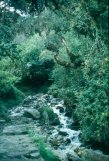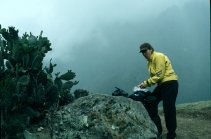|
|
Inca Trail - The Bus Ride by Joe Mazzarella - added January 31, 2007

 How far will we walk today? Did we bring enough food? Should we
have taken the train to the trailhead instead of this heinous bus? Why was the
Inca Trail ever built? How much will it rain? Will Machu Picchu live up to the
hype? Should we have hired a guide and porters? Am I the only one in this bus
who wants the windows open? How far will we walk today? Did we bring enough food? Should we
have taken the train to the trailhead instead of this heinous bus? Why was the
Inca Trail ever built? How much will it rain? Will Machu Picchu live up to the
hype? Should we have hired a guide and porters? Am I the only one in this bus
who wants the windows open?
 We were about to start the most famous hike in South America,
and these questions and more rang through my head. After four and a half hours on
the bus, Julie and I were finally walking along the Urabamba River. From here we
enjoyed the agaves and cactus-ridden dry lands of the Andes, with giant glaciated
peaks towering in the distance. The stress of the busy Cusco streets and the
uncomfortable bus ride seemed far behind us. The rain poured down at a steady
rate as the trail meandered casually uphill along the Cusichaca River through
potato farmlands and past the small village of Wallaybamba. This would be our
last chance to hire a porter or grab a coke. We happily neglected both and trudged
on. The rest of the day was spent climbing steadily up the steep trail and through
a dense, damp forest of polylepis woodland, with its twisting limbs and thick vegetation. We were about to start the most famous hike in South America,
and these questions and more rang through my head. After four and a half hours on
the bus, Julie and I were finally walking along the Urabamba River. From here we
enjoyed the agaves and cactus-ridden dry lands of the Andes, with giant glaciated
peaks towering in the distance. The stress of the busy Cusco streets and the
uncomfortable bus ride seemed far behind us. The rain poured down at a steady
rate as the trail meandered casually uphill along the Cusichaca River through
potato farmlands and past the small village of Wallaybamba. This would be our
last chance to hire a porter or grab a coke. We happily neglected both and trudged
on. The rest of the day was spent climbing steadily up the steep trail and through
a dense, damp forest of polylepis woodland, with its twisting limbs and thick vegetation.

 Although the long day was taking its toll, the coca leafs wedged
between cheek and gum helped with the climb. The coca leaf is generally either
brewed as a tea or chewed with a small amount of llibta, which is very rich in
lime and will activate the alkaloids of the leaf. The effects we felt were a slight
numbing of the cheek, a bit of energy when the altitude made us lethargic, and helped
control hunger and thirst. I was digging it and made it an afternoon ritual on the
trail. Many Westerners confuse the coca leaf with cocaine, which is a huge mistake.
Cocaine is a highly addictive and toxic drug... the coca leaf is not. Along with
being rich in vitamins (A & E) and minerals, the coca leaf is also used by the
indigenous Andean societies for medicinal, ritual, social, and religious purposes.
Finally the forest cleared and we pitched camp half an hour before dark, overlooking
the valley from where we came. Although the long day was taking its toll, the coca leafs wedged
between cheek and gum helped with the climb. The coca leaf is generally either
brewed as a tea or chewed with a small amount of llibta, which is very rich in
lime and will activate the alkaloids of the leaf. The effects we felt were a slight
numbing of the cheek, a bit of energy when the altitude made us lethargic, and helped
control hunger and thirst. I was digging it and made it an afternoon ritual on the
trail. Many Westerners confuse the coca leaf with cocaine, which is a huge mistake.
Cocaine is a highly addictive and toxic drug... the coca leaf is not. Along with
being rich in vitamins (A & E) and minerals, the coca leaf is also used by the
indigenous Andean societies for medicinal, ritual, social, and religious purposes.
Finally the forest cleared and we pitched camp half an hour before dark, overlooking
the valley from where we came.
[Machu Picchu, Day 4] [Travel Journal Index] [Dead Women's Pass, Day 2]
|
|

